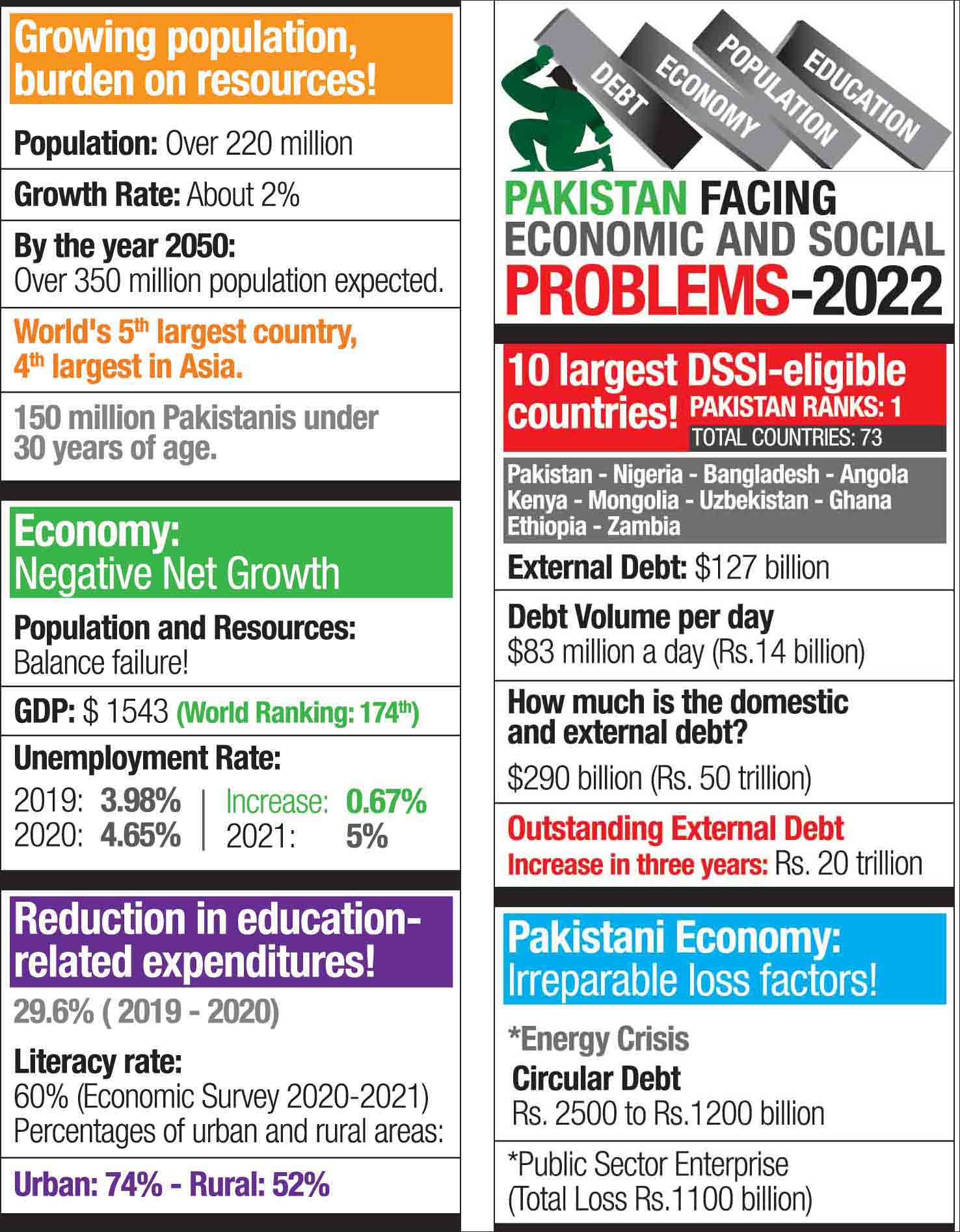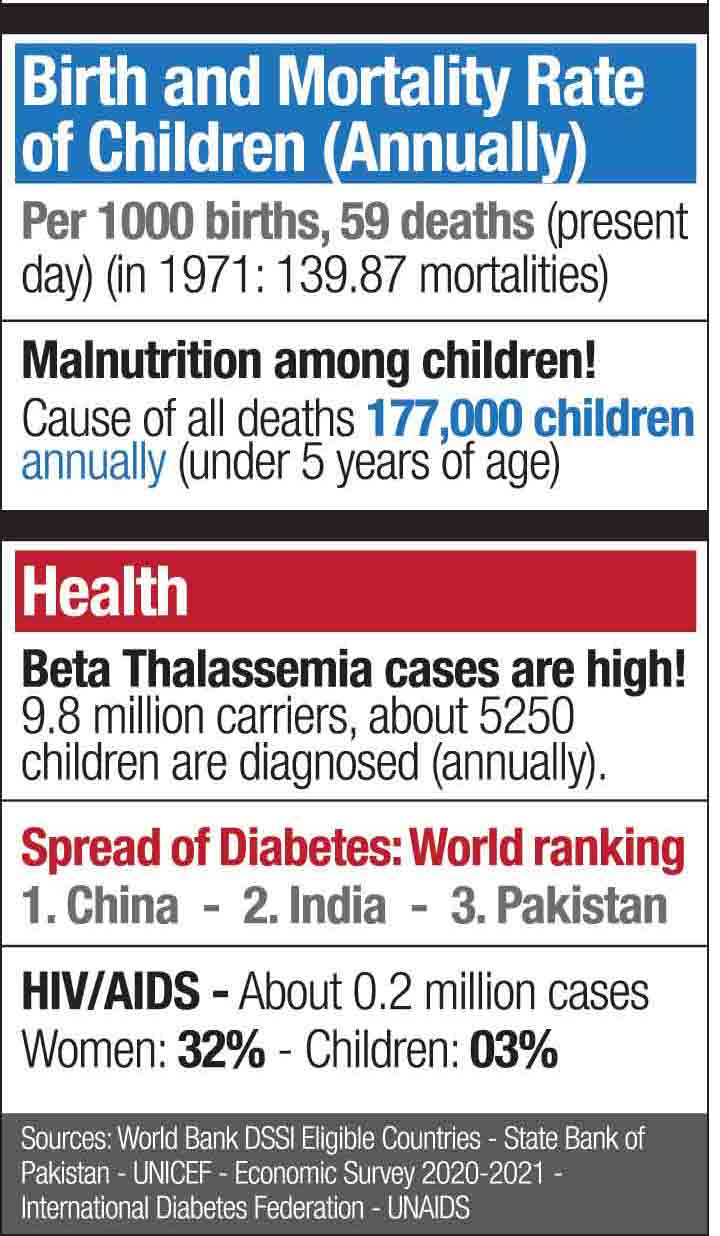Pakistan entering New Year with mammoth issues
Pakistan tops the list of 10 countries with highest external debt out of 73 states eligible for World Bank’s Debt Service Suspension Initiative
ISLAMABAD: Pakistan is entering the new year — 2022 — with a challenge to lessen the burdens of mammoth increase in national debt, waste of national resources, burgeoning population, rising unemployment, poor health and education facilities.
According to World Bank, SBP, UNICEF, Economic Survey, International Diabetes Federation and UNAID data, Pakistan topped the list of 10 countries with highest external debt out of 73 states eligible for World Bank’s Debt Service Suspension Initiative. After Pakistan, Nigeria, Bangladesh, Angola, Kenya, Mongolia, Uzbekistan, Ghana, Ethiopia and Zambia fall in the list. Pakistan’s external debt stand at $127 billion.
Pakistan is borrowing Rs14 billion daily to meet its expenses, and its domestic and external debt has reached $280 billion (Rs50,000 billion) which is 94 per cent of the GDP. Pakistan’s sitting government has added Rs20,000 billion during its term with a rising debt of $127 billion.
Energy crisis and public sector enterprises are causing irreparable damage to economy. Pakistan’s circular debt that is around Rs1200-2500 billion is almost equal to the annual budget.
Pakistan’s nominal GDP per capita is $1,542 and it ranks 181st in the world. As far as purchasing power parity is concerned, it is $5,964 per capita and according to this standard, Pakistan ranks 174th on the world. Population explosion is putting pressure on resources and Pakistan is the world’s fifth most populous country with a population of almost 22 million.
Among Asia’s 55 most populous countries, Pakistan ranks fourth with a population growth rate of two percent. By 2050, Pakistan’s population is expected to rise to 35 million and the country’s net growth is negative. This means that the country has failed to generate resources in proportion to growing population.
Of 22 million Pakistanis, 15 million are under 30 years of age and being jobless they are unable to contribute to the country’s growth. It can be gauged from the fact that in 2020, the joblessness rate in Pakistan was 4.65 per cent which is 0.67 per cent higher than in 2019. This ratio could reach 5 per cent in 2021.
According to the Economic Survey 2020-21, the literacy rate in Pakistan could not exceed 60 per cent. There was a 29.6 per cent reduction in educational expenditures in 2019-20. The Economic Survey said the literacy rate is higher in urban areas than in rural areas. The literacy rate in cities is 74 per cent and in rural areas 52 per cent. According to the UNICEF, 59 out of 1,000 newborns die within a year of their birth. In 1971, this number was 139.87. There are many cases of Beta Thalassaemia in Pakistan and its patients are 9.8 millions. Every year, 5250 children are diagnosed with Beta Thalassaemia. As regards diabetes, Pakistan is on No 3 after China and India. According to the UN AIDS, there are 2,000,000 AIDS patients in Pakistan. Of them, 32 per cent are women and 3 per cent children. In such a situation, will the New Year give the good news of reduction in these problems besides a better economy?
-
 OpenAI And ServiceNow Team Up To Embed ChatGPT In Business Workflows
OpenAI And ServiceNow Team Up To Embed ChatGPT In Business Workflows -
 Johnny Depp Prepares For His Massive Comeback After Years Of Struggle
Johnny Depp Prepares For His Massive Comeback After Years Of Struggle -
 Meghan Markle Is Ready To Put A Cork In It All By Giving Prince Harry Baby No. 3: ‘She Wants A Break’
Meghan Markle Is Ready To Put A Cork In It All By Giving Prince Harry Baby No. 3: ‘She Wants A Break’ -
 Billie Eilish Speaks Out Against Authority: 'It's Very Strange'
Billie Eilish Speaks Out Against Authority: 'It's Very Strange' -
 'Greenland Will Stay Greenland', Former Trump Adviser Hints At New Twist
'Greenland Will Stay Greenland', Former Trump Adviser Hints At New Twist -
 Brooklyn Beckham's Wedding Dance With Mom Victoria Sparks Hilarious Memes
Brooklyn Beckham's Wedding Dance With Mom Victoria Sparks Hilarious Memes -
 King Charles' Latest Photos A Statement On His Health?
King Charles' Latest Photos A Statement On His Health? -
 Tom Cruise's Biggest Dream Crushed By The President?
Tom Cruise's Biggest Dream Crushed By The President? -
 King Charles, Queen Camilla Send Message To King Of Spain After Train Crash
King Charles, Queen Camilla Send Message To King Of Spain After Train Crash -
 'We Believe Brooklyn': David Beckham Trolled After Son's Statement
'We Believe Brooklyn': David Beckham Trolled After Son's Statement -
 Microsoft CEO Says AI Must Deliver Real World Impact To Survive
Microsoft CEO Says AI Must Deliver Real World Impact To Survive -
 Stranger Knocks, Then Opens Fire On Indiana Judge And Wife
Stranger Knocks, Then Opens Fire On Indiana Judge And Wife -
 Priscilla Presley's Derogatory Remarks On Late Daughter Lisa Marie Reignite Controversy
Priscilla Presley's Derogatory Remarks On Late Daughter Lisa Marie Reignite Controversy -
 Japan Unveils Anti-ship Missile With ‘barrel-roll’ Evasion To Outsmart Defenses
Japan Unveils Anti-ship Missile With ‘barrel-roll’ Evasion To Outsmart Defenses -
 How Brooklyn Beckham 'mentor' Prince Harry Inspiring Him To Speak Against Family?
How Brooklyn Beckham 'mentor' Prince Harry Inspiring Him To Speak Against Family? -
 Zac Efron, Kenny Ortega Revisit 'High School Musical' After 2 Decades
Zac Efron, Kenny Ortega Revisit 'High School Musical' After 2 Decades






